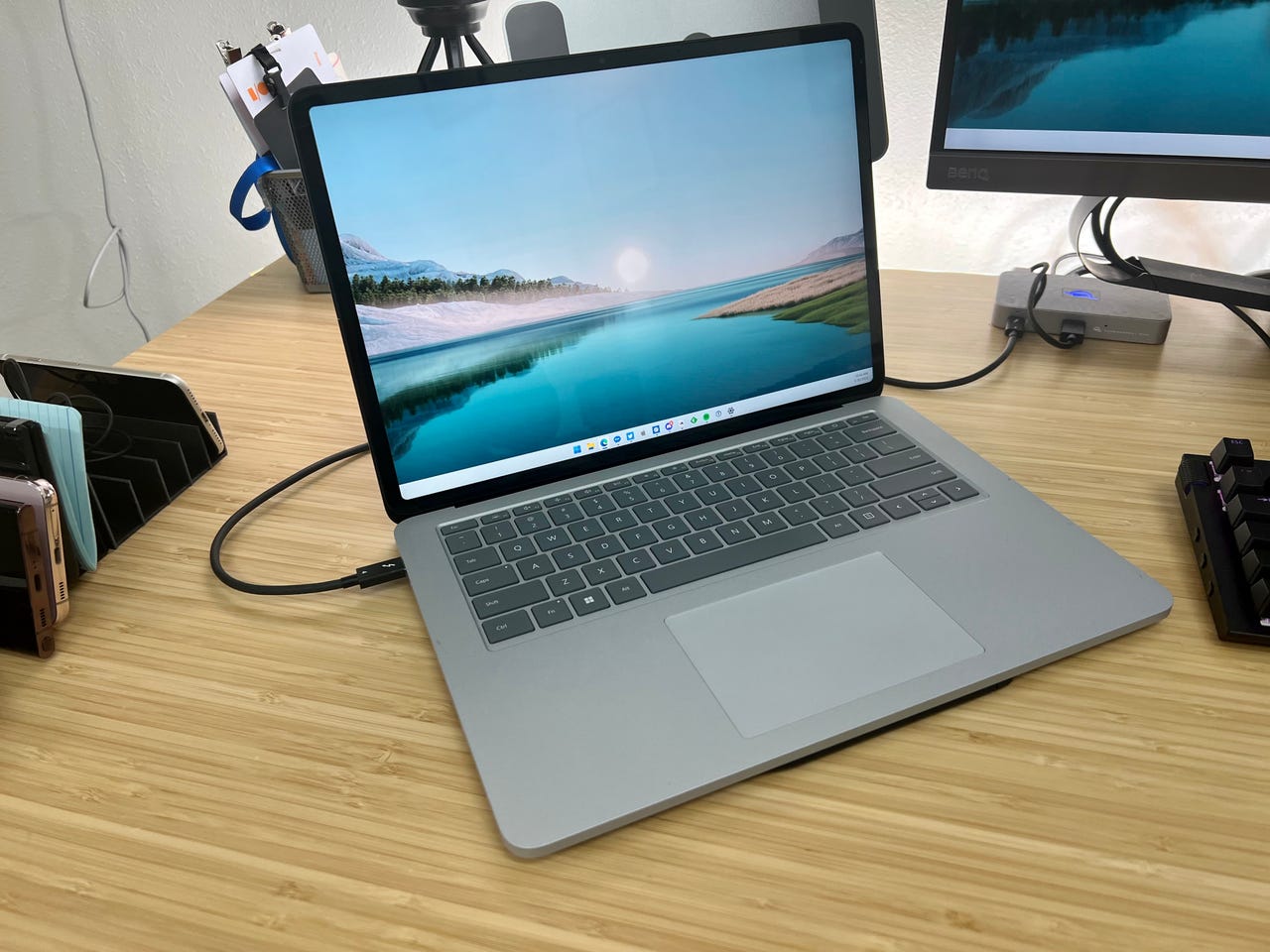































 Jason Cipriani/ZDNet
Jason Cipriani/ZDNet Microsoft's Surface lineup is full of devices designed for specific use cases. Of course, there's the standard Surface Laptop line, with performance and price spanning a wide range. Then there's theSurface Pro 8 andSurface Pro X offering a true 2-in-1 experience. But then, there's a line of products that I like to view as a way of testing the market -- seeing what users will do with unique products. For example, the Surface Book is a unique device in that the screen is physically detached from the keyboard, turning into a dedicated -- and true -- tablet with the press of a button.
More recently, Microsoft announced theSurface Laptop Studio a unique approach to a laptop and tablet hybrid. Instead of detaching the display from the base, you can fold and move the display around to different positions with little effort. There's a ledge underneath the keyboard that goes around the entire laptop, with a spot on the front of the Laptop Studio to store and charge a Microsoft Surface Slim Pen 2.
It's yet again a unique approach to what a laptop is and can do, and for the last few weeks, I've been using one. Below are three of my key takeaways. For a full review, make sure to read fellow ZDNet contributor Simon Bisson's take.
Yes, I'm going there. It's an argument that's very tired by now, but the more I use touchscreen-equipped Windows laptops and myiPad Pro , the more I want to reach out and touch the screen on myMacBook . Touch is an incredibly intuitive way to interact with computers, big and small. It's how we type, select and even take photos on our smartphones. Our brains have been wired and rewired to look for touchpoints when using a computer, so reaching up to tap on an X to close out a window or quickly swipe with a finger to scroll through a long document or website is something that just makes sense.
Granted, Microsoft has spent years optimizing Windows to be a touch-friendly interface, and the company got a lot wrong along the way. But Windows 11, and for that matter, later builds of Windows 10, have gotten a lot of it right.
For example, in Windows 11, swiping in from the left side of the screen reveals several widgets that have replaced Live Tiles that lived in the start menu. A swipe in from the right side of the screen shows notifications and the calendar. Tapping on the Wi-Fi/Volume/Battery icon on the taskbar brings up a settings panel that has large touch targets for routine settings, like Bluetooth and screen brightness (along with the previously mentioned settings, of course).
In a lot of ways, Apple has started to lay the groundwork for a touch friendlier MacOS interface. Taking common settings as an example, Control Center on a Mac looks a lot like it does on iOS and iPadOS -- with giant touch targets that just beg to be touched or swiped across. There's still a lot of work to be done for MacOS to be at the same level as Windows 11 when it comes to touch interactions, but it certainly feels like that's the direction Apple is moving. Or maybe my personal bias is reading into it too much.
Here are 's top picks for a variety of use cases.
Read nowI know what you're thinking."Didn't he just say touchscreen laptops are here to stay?"I did. And I stand by that. But, when folding the Laptop Studio's display so it lays flat on the deck, I'm not convinced it makes a great tablet. The only reason I say that is because it's heavy. Really heavy.
If you get a Laptop Studio with an i5 processor, it weighs 3.83-pounds. Go with the i7 processor? Bump up that weight to an even 4-pounds.
If you stick to using the Laptop Studio in tablet mode while leaving it flat on your desk, then the weight won't matter at all. But, if you want to carry it around as a tablet, the weight is going to, uh, weigh on you.
That said, laying the screen flat and using theSlim Pen 2 to draw, sketch or edit photos makes a lot of sense and is a comfortable way of using the Laptop Studio.
I'm not a regular user of a stylus on any device that supports one, be it the iPad Pro or the Laptop Studio. But, in a bid to ensure thorough testing, I did attach my Slim Pen 2 to the front of the Laptop Studio's housing, just under the keyboard. Microsoft has a spot there for the pen that magnetically holds it in place while simultaneously charging it. I anticipated that at some point while carrying around the Laptop Studio or moving it around on my lap while using it, I'd knock the Slim Pen 2 off of the housing. Actually, I expected to routinely knock it off and eventually give up on placing it there.
But over the last few weeks, not once have I bumped it or knocked it off of the housing. And, in the few instances where I've forced myself to use it for a little bit, it's been readily available.
Overall, I really like usingthe Surface Laptop Studio . The display is gorgeous, and the ability to unlock the laptop using Windows Hello's facial recognition is yet another thing I'd love to see Apple add to its MacBook line via Face ID (the notch is already there!).
Now if you'll excuse me, I have to go wipe the fingerprints off myMacBook Pro 's display. They're annoying me.
 Etiquetas calientes:
tecnología
Nuestro proceso
computación
Ordenadores portátiles
Etiquetas calientes:
tecnología
Nuestro proceso
computación
Ordenadores portátiles